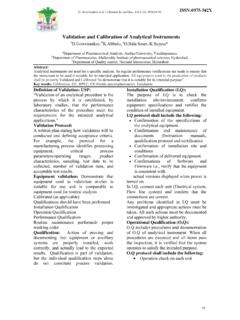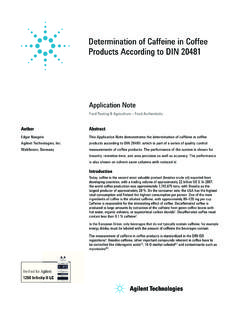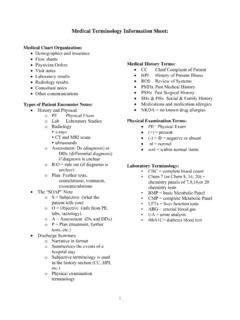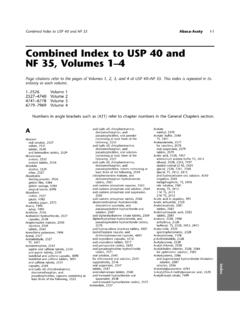Transcription of Validation and Calibration of Analytical Instruments
1 Validation and Calibration of Analytical Instruments , , Souri, * aDepartment of Pharmaceutical Analysis, Andhra University, Visakhapatnam. bDepartment of Pharmaceutics, Mallareddy Institute of pharmaceutical sciences, Hyderabad, cDepartment of Quality control, Neuland laboratories, Hyderabad. Abstract: Analytical Instruments are used for a specific analysis. So regular performance verifications are made to ensure that the instrument to be used is suitable for its intended application. All equipments used in the production of products shall be properly Validated and Calibrated to demonstrate that it is suitable for its intended purpose . Key words: Calibration , GC, HPLC, UV-Visible spectrophotometer, Validation . Definition of Validation : USP: Validation of an Analytical procedure is the process by which it is established, by laboratory studies, that the performance characteristics of the procedure meet the requirements for the intended Analytical applications.
2 Validation Protocol: A written plan stating how Validation will be conducted and defining acceptance criteria. For example, the protocol for a manufacturing process identifies processing equipment, critical process parameters/operating ranges, product characteristics, sampling, test data to be collected, number of Validation runs, and acceptable test results. Equipment Validation : Demonstrate that equipment used in Validation studies is suitable for use and is comparable to equipment used for routine analysis Calibrated (as applicable) Qualifications should have been performed Installation Qualification Operation Qualification Performance Qualification Routine maintenance performed- proper working order Qualification: Action of proving and documenting that equipment or ancillary systems are properly installed, work correctly, and actually lead to the expected results.
3 Qualification is part of Validation , but the individual qualification steps alone do not constitute process Validation . Installation Qualification ( ): The purpose of is to check the installation site/environment, confirms equipment specifications and verifies the condition of installed equipment. protocol shall include the following: Confirmation of the specifications of the Analytical equipment. Confirmation and maintenance of documents (Instruction manuals, qualification protocol and certificates). Confirmation of installation site and conditions Confirmation of delivered equipment. Confirmations of Software and Firmware , verify that the equipment is consistent with actual versions displayed when power is turned on.
4 In , connect each unit (Electrical system, Flow line system) and confirm that the connections are correct. Any problems identified in must be investigated and appropriate actions must be taken. All such actions must be documented and approved by higher authority. Operational Qualification ( ): includes procedures and documentation of of Analytical instrument. When all procedures are executed and all items pass the inspection, it is verified that the system operates to satisfy the intended purpose. protocol shall include the following: Operation check on each unit D. Gowrisankar et al / J Biomed Sci and Res., Vol 2 (2), 2010,89-9989 o Due to modular nature of the system, the operation of each unit is checked properly.
5 Operation check on overall system o Confirm that the system controller and work station control each unit during analysis and that the analysis results meet the prescribed criteria. Software and Firmware check Here Firmware checking is conducted based on version display and Software certificate of Compliance. The Software and Firmware must be properly managed and change procedures must be properly clarified. Any problems identified in must be investigated and appropriate actions must be taken. All such actions must be documented and approved by higher authority. Prior to implementing , check the system configuration, determine the items to be evaluated and record them in record and have them approved.
6 Performance Qualification (PQ): The objective is to ensure that the instrument is performing within specified limits. Hence documented verification that the equipment and ancillary systems, as connected together, can perform effectively and reproducibly based on the approved process method and specifications. The PQ represents the final qualification of equipment or system. This incorporates a range of testing to simulate your production process options and provide assurance that systems and operating documentation are capable of subsequent process Validation activities. It is used to establish and or confirm; 1. Definition of performance criteria and test procedures.
7 2. Selection of critical parameters, with predefined specifications. 3. determination of the test intervals, , (a) - Everyday. (b) - Every time the system is used. (c) - Before, between and after a series of runs. 4. Define corrective actions on what to do if the system does not meet the established criteria. Definition of Calibration : ICH The demonstration that a particular instrument or device produces results within specified limits by comparison with those produced by a reference or traceable standard over an appropriate range of measurements. Calibration of HPLC: Various Calibration parameters are: Flow rate accuracy Injector accuracy System Precision Wavelength accuracy Detector linearity Injector linearity Gradient Performance Check Column oven temperature accuracy Flow Rate Accuracy: 1.
8 Prime all the solvent lines with Milli Q water. 2. Set the flow rate to ml/m. 3. Wait for about 15 m to stabilize the system and ensure that the pressure is stable. 4. Insert the outlet tubing into a 10 ml volumetric flask and start the stop watch simultaneously. 5. Stop the stopwatch when the lower meniscus reaches the 10 ml mark on the flask. 6. Record the elapsed time. 7. Similarly check the flow for ml/m and ml/m. Acceptance criteria: The time taken to collect the water should be with in of the actual value. D. Gowrisankar et al / J Biomed Sci and Res., Vol 2 (2), 2010,89-9990 PQ Relationships Table 1: And And Report System Name: System ID No.: Installation site: Performer_____Signature _____Date:_____ Reviewer_____Signature_____Date:_____ Manager_____Signature_____Date:_____ Table 2: Flow Rate Accuracy Set Flow Actual time required to collect up to the mark in m Acceptance criteria (in m) ml/m ml/m ml/m D.
9 Gowrisankar et al / J Biomed Sci and Res., Vol 2 (2), 2010,89-9991 Table 3: Chromatographic Conditions for System Precision Column Flow rate Detection injection volume Run time Column oven temperature Mobile phase C18,150mm mm,5 m ml/m UV at 272 nm 20 l 15 m 25 C 2 C Water: Methanol (70:30v/v) Injector Accuracy: 1. Connect the pump and detector inlet with union. 2. Prepare mobile phase consisting of a mixture of water and Methanol (70:30 v/v) 3. Set a flow rate of ml/m and a run time of 1 m. 4. Set the column temperature at 25 2 C. 5. Fill a standard HPLC vial to 2/3rd with Milli-Q water. Seal the vial properly with a cap. 6. Weigh the vial and record the weight as W1 grams. 7. Place the vial in the chromatographic system and perform 6 injections of 50 l volume from this vial.
10 8. Weigh the vial again and note the weigh after the injections as W2 grams. Calculate the mean volume injected per injection as follows: Mean injected volume ( l) = (W1 W2) 100/6 Acceptance criteria: The mean injected volume should be l. System Precision: Standard Preparation: Accurately weigh and transfer about 60mg of caffeine into a 100ml volumetric flask. Dissolve and dilute to the volume with mobile phase. Transfer 10ml of this solution into a 100ml volumetric flask and dilute to the volume with mobile phase. Procedure: Inject blank, followed by standard preparation in 6 replicates. Note down the areas and retention times.





